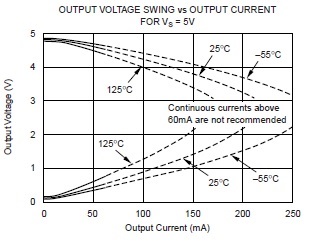I'm a test engineer and we are testing OPA2356 for a customer and are consistently failing the "Voltage Output Swing from Rail" parameter based on the values reported in the datahseet at 25C. The upper limit specified for the max voltage swing from the supply rail is 1V. However, despite our best efforts, we are consistently seeing a value approximately 35 to 40 mV greater than 1V for the max output swing from the negative rail (-2.5V) for opamp A (Note: we have configured the power rails for mid supply at -2.5V and +2.5V). In the same datasheet, there is a graph of Output Voltage versus Output Current at various temperatures. For the curve at 25C, the max allowed voltage swing from the negative rail at 100 mA appears to be much closer to 1V than the max allowed voltage swing from the positive rail at the same current and temperature--being less than 1V by a greater amount. Does the limit value for the output voltage swing stated in the datasheet apply only to the positive rail (+2.5V) at 100 mA or is it equally applicable to the negative rail (-2.5V) despite the narrower margin illustrated in the graph? The graph also states "Continuous current above 60mA are not recommended" but the max output voltage swing parameter is specified at Io=100 mA. Should that particular parameter value be measure only under pulsed current conditions (<300 us)? Does the graph of output voltage swing versus current for Vs=5V support the max 1V limits specified earlier in the datasheet? Any help you could offer would be greatly appreciated. Thanks.
-
Ask a related question
What is a related question?A related question is a question created from another question. When the related question is created, it will be automatically linked to the original question.


